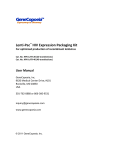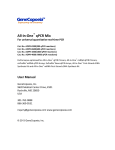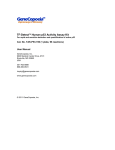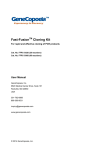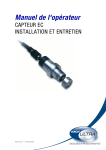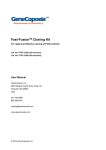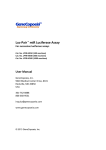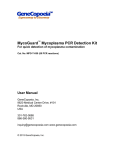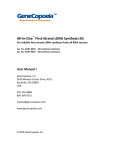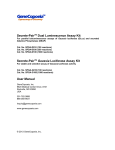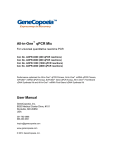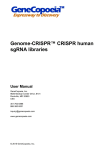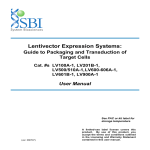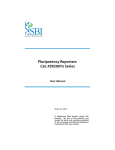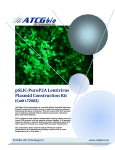Download Lenti-Pac™ HIV Expression Packaging Kit For optimized production
Transcript
G eneCopoeia Expressway to Discovery TM Lenti-Pac™ HIV Expression Packaging Kit For optimized production of recombinant lentivirus Cat. No. HPK-LvTR-20 (20 transfections) Cat. No. HPK-LvTR-40 (40 transfections) User Manual Version V GeneCopoeia, Inc. 9620 Medical Center Drive, #101 Rockville, MD 20850 USA 301-762-0888 or 866-360-9531 [email protected] www.genecopoeia.com © 2009 GeneCopoeia, Inc. Lenti-Pac™ HIV Expression Packaging Kit User Manual USER MANUAL Lenti-Pac™ HIV Expression Packaging Kit I. II. III. IV. V. VI. VII. VIII. Introduction Kit Contents and Storage Additional Materials Required or Recommended Getting Started Lentivirus Production Lentivirus Titer Estimation by Transduction Transduction of Target Cells with Lentiviruses Limited Use License and Warranty I. Introduction GeneCopoeia has multiple sets of over 40,000 human and mouse ORF expression clones as well as multiple sets of small hairpin RNAi (shRNA) clones against genome-wide target genes from human, mouse, rat, and other mammals in HIV-based lentiviral vector systems. In addition, GeneCopoeia offers precursor microRNA (miRNA) expression and miRNA inhibitor clones for all known human, mouse and rat miRNAs in a HIV-based lentiviral vector system. HIV- (human immunodeficiency virus) based vectors are currently the most popular lentiviral-based expression systems and are very effective at transducing genes into a wide variety of dividing and non-dividing mammalian cells, both in vitro and in vivo. The lentiviral expression vectors can integrate into the genome of the target cells, resulting in the stable expression of transgenes. The GeneCopoeia third generation HIV-based lentivector systems meet Biosafety Level 2 (BSL-2) requirements based on the criteria published by the Centers for Disease Control. ™ The GeneCopoeia Lenti-Pac HIV Expression Packaging System includes an optimized lentiviral packaging ™ plasmid mix, an eGFP positive control plasmid, a new transfection reagent, EndoFectin optimized for virus ™ production and TiterBoost reagent that further increases the titers 5-10 fold. When combined with GeneCopoeia HIV-based lentiviral constructs the results are high titers and robust expression levels. The Lenti-Pac HIV Expression Packaging System safely ensures efficient expression of recombinant transcripts in mammalian cells. Advantages of OmicsLink™ lentiviral ORF expression and shRNA clones, miExpress™ precursor miRNA expression and miArrest™ miRNA inhibitor clones High efficiency of gene delivery to virtually all mammalian cell types in vitro as well in vivo High expression levels of delivered genes (ORF expression clones) High knockdown efficiency against target mRNA transcripts (shRNA clones) High expression translation suppression of target genes and/or mRNA cleavage/degradation (miRNA clones) Self-inactivation and no unwanted viral replication 2 Lenti-Pac™ HIV Expression Packaging Kit User Manual II. Contents and Shipping/ Storage Contents and storage recommendations for the Lenti-Pac HIV Expression Packaging Kits (Cat. No. HPK-LvTR-20/HPK-LvTR-40) are provided in the following table. Contents Quantity Shipping temperature Storage temperature/ conditions 4–8°C (Stable for at least 6 months) HIV packaging mix eGFP positive control plasmid EndoFectin Lenti transfection reagent 100 μl (0.5 μg/μl) 200 μl (0.5 μg/μl) 25 μl (0.06 μg/μl) 25 μl (0.06 μg/μl) 500 μl Ambient 4–8°C (Stable for at least 6 months) Ambient Ambient 1ml TiterBoost™ Reagent (500x) 500 μl Alternatively, the packaging mix can be stored at -80 °C in usable aliquots. Avoid repeated freezing/ thawing. Ambient Alternatively, the packaging mix can be stored at -80 °C in usable aliquots. Avoid repeated freezing/ thawing. 4–8°C (Stable for at least 12 months) 4–8°C (Stable for at least 12 months) 1ml III. Additional Materials Required or Recommended 1. GeneCopoeia GCI-L3 chemically competent cells (GeneCopoeia Cat No. STK300-10). Alternatively, Stbl3™ chemically competent cells (Invitrogen Cat No. C7373-03) may be used. 2. GeneCopoeia 293Ta Lentiviral packaging cell line (GeneCopoeia Cat No. Clv-PK-01). Alternatively, the HEK 293T/17 cell line (ATCC Cat No. CRL-11268) can also be used. 3. H1299 cell line (ATCC Cat No. CRL-5803), or HT-1080 cell line (ATCC Cat No. CCL-121) for lentivirus titer estimation. H1299 cells are preferred over HT-1080 cells for lentivirus titration. 4. DMEM with glucose, L-glutamine and sodium pyruvate (Mediatech Cat No. 10-013-CV) 5. Fetal bovine serum (Thermo Scientific Cat No. SH300700.02) ® 6. Opti-MEM I Reduced-Serum Medium (Invitrogen Cat No. 31985-062/31985-070). ® 7. Polybrene (Sigma-Aldrich Cat No. H9268): 10 mg/ml solution dissolved in 150 mM NaCl and sterile-filtered. o o Store usable aliquots at -20 C. Working stock can be stored at 4 C for up to two months. 8. Crystal Violet (Sigma-Aldrich Cat No. C3886): 0.5% (W/V) solution dissolved in 25% methanol. 9. Penicillin-Streptomycin for mammalian cell culture (Sigma-Aldrich Cat No. P4333) 10. Antibiotics for selecting stably transduced cells: puromycin (Invivogen Cat No. ant-pr-1/ant-pr-5), hygromycin B (Invivogen Cat No. ant-hm-1/ant-hm-5), Neomycin (G-418) (Invivogen Cat No. ant-gn-1/ant-gn-5) ® 11. BD Falcon 5-ml or 14-ml Tubes (BD Falcon Cat No. 352053/352059). 3 Lenti-Pac™ HIV Expression Packaging Kit User Manual IV. Getting Started Upon receipt of a new lentiviral expression plasmid, it is recommended to transform the plasmid into GeneCopoeia GCI-L3 Chemically Competent E. coli Cells (GeneCopoeia Cat No. STK300-10), or any Stbl3™-equivalent competent cell strain, and to prepare plasmid DNA with a proven plasmid DNA purification method. GeneCopoeia lentiviral ORF expression, shRNA or miRNA constructs contain the ampicillin resistance gene. Quality of plasmid It is critical to use plasmid of the highest quality. Determine the DNA concentration by reading the absorption at 260 nm. DNA purity is measured by using the 260 nm / 280 nm ratio (the ratio should be in the range of 1.8 to 2.0). Check the integrity of the plasmid by agarose gel electrophoresis. Condition of cells Always use healthy cells that are well maintained and passaged regularly. Make sure the culture is free from bacteria, fungi, or Mycoplasma contamination. If the cells are from a recent liquid nitrogen stock, passage the cel ls at least 2 times before transfection. V. Lentivirus Production The GeneCopoeia HIV-Based Lentiviral Expression System is a modified version of the third generation selfinactivating (SIN) lentiviral vector system which incorporates enhanced bio-safety features and is optimized for production of high viral titers. In this system, recombinant lentiviral particles are generated by co-transfecting an HIV-based lentiviral expression plasmid together with the GeneCopoeia Lenti-Pac HIV Expression Packaging Kit into GeneCopoeia 293Ta lentiviral packaging cells (GeneCopoeia Cat No. CLv-PK-01). The lentiviral ORF/shRNA/miRNA expression plasmid (lentiviral transfer vector) contains the elements required for packaging, transduction and stable integration of the viral expression construct into genomic DNA leading to expression of the ORF or shRNA hairpin. However, it lacks the elements essential for transcription and packaging of an RNA copy of the ORF/shRNA/miRNA expression plasmid into recombinant pseudoviral particles. These elements are provided by the Lenti-Pac HIV packaging mix, an optimized mixture of plasmids that express the structural, regulatory, and replication genes required to produce lentivirus. See figure 1 below for schematics of this process. The lentivirus generated with this system is pseudotyped with vesicular stomatitis virus-G protein (VSV-G) which exhibits wide cell tropism and generates high titers. In addition to Lenti-Pac HIV packaging mix, this kit also includes a positive control lentiviral transfer vector that expresses the eGFP protein, EndoFectin Lenti Reagent (Cat No. EFL1001-01), and TiterBoost reagent. The EndoFectin Lenti transfection reagent is optimized for transferring plasmids into packaging cells. It guarantees higher transfection efficiency and lower cell toxicity compared to other commercially available transfection reagents. The unique TiterBoost reagent from GeneCopoeia enhances the production of lentiviral particles. 4 Lenti-Pac™ HIV Expression Packaging Kit User Manual Figure 1. Schematics of Lentivirus production and infection of target cells The following procedure provides optimized steps for lentivirus production in 293Ta packaging cells. The yield of 7 recombinant lentiviral particles typically produced under these optimized conditions is 10 ml of 1–10 x10 infection units (ifu) per ml of un-concentrated supernatant from one 10-cm culture dish for eGFP or mCherry positive controls. 8 This amount of pseudoviral particles is generally sufficient to infect 1–10 x10 target cells at a MOI (multiplicity of infection) equal to 1. The titers of lentivirus decrease as the size of insert increases. Actual lentivirus titers for your gene of interest will vary accordingly. Caution: Following this protocol results in the production of pseudoviral particles capable of infecting mammalian cells. The recommended guidelines for working with BSL-2 safety class must be adhered to. 1. Plate packaging cells 6 Two days before transfection, plate 1.3–1.5 x10 of the GeneCopoeia 293Ta lentiviral packaging cells or comparable cells in a 10-cm dish in 10 ml of DMEM supplemented with 10% heat-inactivated fetal bovine serum so that the cells are 70–80% confluent at the moment of transfection. Incubate the cells at 37°C with 5% CO2. Note: Plating the packaging cells 2 days prior to transfection significantly increases the titer of lentivirus. Use heat-inactivated fetal bovine serum for lentivirus production. Heat-inactivated serum can be purchased from other vendors or prepared by incubating thawed serum for 30 minutes at 56°C with gentle shaking. 2. Prepare DNA/EndoFectin Lenti complex In a sterile polypropylene tube, dilute 2.5 µg of lentiviral ORF/shRNA/miRNA expression plasmid and 5.0 µl ® (0.5 µg/µl) of Lenti-Pac HIV mix into 200 µl of Opti-MEM I (Invitrogen). In a separate tube, dilute 15 µl of EndoFectin Lenti into 200 µl of Opti-MEM I. Add diluted EndoFectin Lenti reagent drop-wise to the DNA solution while gently vortexing the DNA-containing tube. Do not reverse the addition sequence. Use round- 5 Lenti-Pac™ HIV Expression Packaging Kit User Manual ® bottom polypropylene tubes such as Falcon 5-ml or 14-ml tubes (BD) for larger volumes. Incubate the mixture for 10–25 minutes at room temperature to allow the DNA-EndoFectin complex to form. Note: The DNA-EndoFectin complex must be formed in the absence of proteins even though the complex is able to transfect cells in the presence of proteins such as 10% serum. Opti-MEM I is recommended for diluting both DNA and EndoFectin Lenti reagent. Serum-free DMEM can be used in place of Opti-MEM I but the transfection efficiency will be compromised. The ratio of 3.0 µl of EndoFectin Lenti per 1 µg of plasmid has been found to be optimal. Increasing the ratio does not further improve transfection efficiency. 3. Transfect packaging cells Add the DNA-EndoFectin Lenti complex directly to each dish and gently swirl the dish to distribute the complex. Incubate the cells in a CO2 incubator at 37°C overnight (8–14 hours). Replace the overnight culture medium with fresh DMEM medium supplemented with 2–5% heat-inactivated fetal bovine serum and penicillinstreptomycin. Add 1/500 volume of the TiterBoost reagent to the culture medium and continue incubation in the CO2 incubator at 37°C. Note: 4. a. Replace the culture medium that contains the DNA-EndoFectin Lenti complex within 16 hours posttransfection. b. TiterBoost reagent at working concentration (1×) typically boosts the titer of lentivirus products 5-10 fold. This reagent is readily removed during commonly used lentivirus concentration/purification procedures such as ultracentrifugation, ultrafiltration and other chromatographic methods. If crude lentiviral particles are used directly to transduce target cells, the volume of lentiviral particles should not exceed 1/10 of that of culture medium; otherwise some adverse effects may occur. TiterBoost at 1/20× or lower concentrations has negligible effects on commonly used mammalian cell lines. It's advised to test the effects of TiterBoost on your target cells beforehand if large volumes of crude lentiviral particles are used. Harvest lentivirus Collect the pseudovirus-containing culture medium in sterile capped tubes 48 hours post transfection and centrifuge the tubes at 500 x g for 10 minutes to get rid of cell debris. Following centrifugation, filter the supernatant through 0.45 µm polyethersulfone (PES) low protein-binding filters. Note: a. Peak virus production is normally achieved 24–48 hours post transfection. Alternatively, lentiviruscontaining medium may be collected multiple times at 36, 48 and 60 hours post-transfection. Lentiviral containing supernatants should be replaced with fresh DMEM supplemented with 2–5% heat-inactivated fetal bovine serum, penicillin-streptomycin and TiterBoost reagent. b. Do not use nitrocellulose filters as nitrocellulose is known to bind lentivirus and reduce titers. The supernatant containing lentiviral particles can be used directly to determine the titer and to transduce target cells in vitro as long as the target cells can survive in conditioned medium. Lentiviral stocks should be aliquoted and stored at -80°C. Expect significant loss of viral titer with each freeze/thaw cycle. VI. Lentivirus Titer Estimation by Transduction At this point it is recommended that the pseudoviral stock is titered to ensure it is viable and to test what fraction of target cells can be transduced. This enables the number of copies of viral construct per target cell to be controlled. There are several methods to determine the titer of pseudovirus stock. The procedure below is based on the transduction of H1299 or HT-1080 cells. Different cells can also be used but titers may vary up to several orders of magnitude. Day 1: Plate H1299 or HT-1080 cells 4 1. Plate ~5 x 10 of the H1299 or HT-1080 cells per well in a 24-well plate 24 hours prior to viral infection. Use 0.5 ml of DMEM supplemented with 10% heat-inactivated fetal bovine serum and penicillin-streptomycin for each well. Incubate the cells at 37°C with 5% CO2 overnight. 6 Lenti-Pac™ HIV Expression Packaging Kit User Manual Day 2: Transduce H1299 or HT-1080 cells 2. Dilute Polybrene to 10 µg/ml with DMEM containing 5% heat-inactivated fetal bovine serum and penicillinstreptomycin. 3. Remove old culture medium from each well. Add 0.25 ml of Polybrene (from Step 2). The final concentration of Polybrene will be 5 µg/ml after adding diluted lentivirus. For each pseudoviral stock, use five wells. 3a. For lentivirus containing a fluorescent marker and to be analyzed with flow cytometry (step 5a): Infect H1299 or HT-1080 cells by adding 0.1 μl of lentivirus (10 μl of 100-fold diluted viral stock) into the first well, 0.5 μl of lentivirus (50 μl of 100-fold diluted viral stock) into the second well, 2.0 μl into the third well, 10 μl into the fourth well, and 50 μl into the fifth well. Add appropriate amount of DMEM containing 5% heat-inactivated serum and penicillinstreptomycin so that the final volume reaches 0.5 ml per well. 3b. For lentivirus to be analyzed by drug selection and colony counting (step 5b-10): Infect H1299 or HT-1080 cells by adding 0.001 μl of lentivirus (10 μl of 10,000-fold diluted viral stock) into the first well, 0.01 μl of lentivirus (10 μl of 1,000-fold diluted viral stock) into the second well, 0.1 μl of lentivirus (10 μl of 100-fold diluted viral stock) into the third well, 0.5 μl of lentivirus (50 μl of 100-fold diluted viral stock) into the fourth well, and 2.0 μl into the fifth well. Add appropriate amount of DMEM containing 5% heat-inactivated serum and penicillin-streptomycin so that the final volume reaches 0.5 ml per well. Place the plates for 2 hours at 4-8°C; then transfer the plates to a 37°C incubator with 5% CO2 and incubate cells overnight. Note: a. Dilute lentivirus with only culture medium. Do not use water or other buffers. b. The optimal concentration of Polybrene depends on cell type and may need to be empirically determined, but is usually in the range of 2–10 µg/ml. Prepare enough for an extra well as a negative control. c. Excessive exposure to Polybrene (>12 hr) can be toxic to some cells. Day 3: Replace medium/split cell culture 4. Trypsinize and transfer the cells to 6-well plates (each 6-well plate will be used for one lentivirus with one control well of non-transduced cells). Incubate in DMEM supplemented with 10% fetal bovine serum and penicillinstreptomycin for additional 48 hours. Day 5: Determine titer by fluorescence analysis (step 5a) or drug selection (5b) 5a. The fraction of eGFP fluorescent cells can be counted by FACS (fluorescent activated cell sorting). Alternatively the eGFP fluorescence may be visualized under a fluorescent microscope. Normally 10 random fields of view are used to estimate the overall fraction of fluorescing cells in each well. The cells are then trypsinized, suspended with complete DMEM, and the total number of cells in each well is determined by using a hemocytometer. The averaged fraction of fluorescent cells is multiplied by the corresponding total cell numbers, then divided by the actual volume –4 of added lentivirus supernatant (in ml, e.g. 0.1 μl equals 10 ml) to determine the titer of the pseudovirus in the supernatant. 5b. For HT-1080 or H1299 cells transduced with lentiviral stocks lacking a fluorescent marker, replace the old medium with fresh complete DMEM containing an appropriate selection drug. (Note: The concentration of the selection drug should be determined empirically beforehand.) Then follow steps 6–10 below: Days 6-14: Select stably transduced cells and count colonies (continued from step 5b) 6. Replace medium with fresh complete medium containing the appropriate selection drug every 3–4 days until drug-resistant colonies become visible (generally 7–14 days after selection). There should not be any colonies in the mock well control. 7. Remove medium and wash dishes twice with cold PBS. 8. Add enough 10% formalin to cover each dish. Incubate for 5 minutes at room temperature to fix the cells. 9. Decant 10% formalin, add 0.5% crystal violet and incubate for 10 minutes at room temperature. 10. Remove the crystal violet solution and wash the dishes with tap water until there is no background staining. Count the blue colonies and calculate the titer of lentiviral stock. 7 Lenti-Pac™ HIV Expression Packaging Kit User Manual Note: Viral titers determined by drug selection/colony counting are significantly lower than those determined by FACS. VII. Transduction of Target Cells with Lentiviruses The transduction efficiency depends upon the target cells and experimental procedure. It is recommended that the titrated pseudoviral stock containing the positive control eGFP is used to determine the concentration of pseudoviral particles required for the desired MOI of the target cells. After these test transductions are performed, it should be possible to determine the optimum concentration of pseudoviral particles for transduction based on eGFP fluorescence. Day 1: Plate cells 4 1. Plate 2–10 x 10 of the target cells per well in a 24-well plate 24 hours prior to viral infection. Use 0.5 ml of DMEM supplemented with 5% heat-inactivated serum and penicillin-streptomycin for each well. Incubate the cells at 37°C with 5% CO2 overnight. Day 2: Transduce target cells 2. For each well, prepare 0.5 ml of virus suspension diluted in complete medium with Polybrene at a final concentration of 5–8 µg/ml. Note: Use several dilutions of pseudoviral stock (0.1 μl to 100 μl). In addition, we recommend including a transduction with the eGFP control and other appropriate positive and negative controls. Mix the virus with the medium gently by rotation or inversion. Do not vortex. 3. Infect the target cells by removing the old culture medium and replacing it with 0.5 ml of diluted viral supernatant. For one well (mock well control), add 0.5 ml of complete DMEM with Polybrene. Place the plates in a 37°C incubator with 5% CO2 and incubate cells overnight. (Optional: Place the plates for 2 hours at 4-8°C; then transfer the plates to a 37°C incubator with 5% CO2 and incubate cells overnight.) Note: Incubating cells with lentivirus for 2 hours at low temperatures can significantly increase the transduction efficien cy. But it may be omitted if the cells cannot tolerate low temperatures. Day 3: Replace medium/Split cell culture 4. Remove the culture medium and replace with 0.5 ml of complete medium (without Polybrene). Or split the cells 1:3 to 1:5 depending on the type of cells, and continue incubating for 48 hours in DMEM. Day 5: Analyze transduced cells or start drug selection of stably transduced cells 5a. The infected target cells can be analyzed for transient expression of transgenes using an appropriate biological assay. If you have used an internal eGFP control, determine the percentage of infected cells by counting fluorescing cells by flow cytometry or with a fluorescent microscope. 5b. To select stably transduced cells, replace old medium with fresh complete medium containing the appropriate selection drug every 3–4 days until drug-resistant colonies become visible (generally 7–14 days after selection). 8 Lenti-Pac™ HIV Expression Packaging Kit User Manual VIII. Limited Use License and Warranty Limited Use License Following terms and conditions apply to use of all OmicsLink™ ORF Expression Clones in all lentiviral vectors and Packaging Kit (the Product). If the terms and conditions are not acceptable, the Product in its entirety must be returned to GeneCopoeia within 5 calendar days. A limited End-User license is granted to the purchaser of the Product. The Product shall be used by the purchaser for internal research purposes only. The Product is expressly not designed, intended, or warranted for use in humans or for therapeutic or diagnostic use. The Product must not be resold, repackaged or modified for resale, or used to manufacture commercial products without prior written consent from GeneCopoeia. This Product should be used in accordance with the NIH guidelines developed for recombinant DNA and genetic research. Use of any part of the Product constitutes acceptance of the above terms. Limited Warranty GeneCopoeia warrants that the Product meets the specifications described in the accompanying Product Datasheet. If it is proven to the satisfaction of GeneCopoeia that the Product fails to meet these specifications, GeneCopoeia will replace the Product. In the event a replace ment cannot be provided, GeneCopoeia will provide the purchaser with a refund. This limited warranty shall not extend to anyone other than the original purchaser of the Product. Notice of nonconforming products must be made to GeneCopoeia within 30 days of receipt of the Product. GeneCopoe ia’s liability is expressly limited to replacement of Product or a refund limited to the actual p urchase price. GeneCopoeia’s liability does not extend to any damages arising from use or improper use of the Product, or losses associated with the use of additional materials or reagents. This limited warranty is the sole and exclusive warranty. GeneCopoeia does not provide any other warranties of any kind, expressed or implied, including the merchantability or fitness of the Product for a particular purpose. GeneCopoeia is committed to providing our customers with high-quality products. If you should have any questions or concerns about any GeneCopoeia products, please contact us at (301)-762-0888. © 2009, GeneCopoeia, Inc. GeneCopoeia, Inc. 9620 Medical Center Drive, #101 Rockville, Maryland 20850 Tel: 301-762-0888 Fax: 301-762-8333 Email: [email protected] Web: www.genecopoeia.com GeneCopoeia Products are for Research Use Only Copyright © 2009 GeneCopoeia, Inc. ™ ™ ™ ™ ™ ™ Trademarks: GeneCopoeia , Lenti-Pac , EndoFectin , TiterBoost , miExpress , miArrest (GeneCopoeia Inc.); ® ™ ® ® Opti-MEM , Stb13 (Invitrogen); Falcon (Bectin, Dickinson & Company); Polybrene (Abbott) LPH5-0710 9









